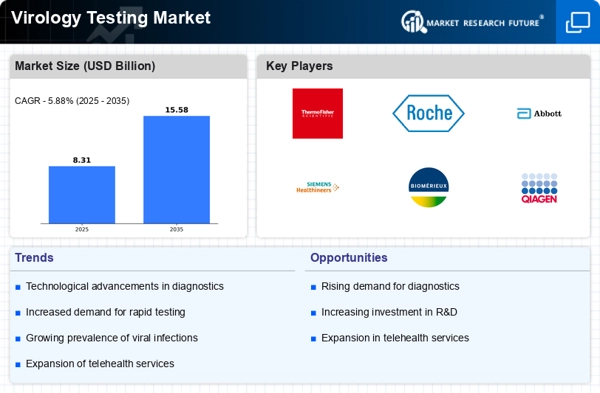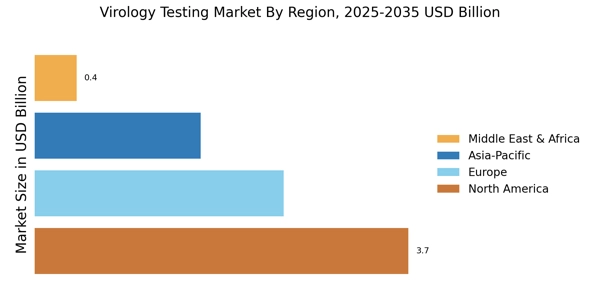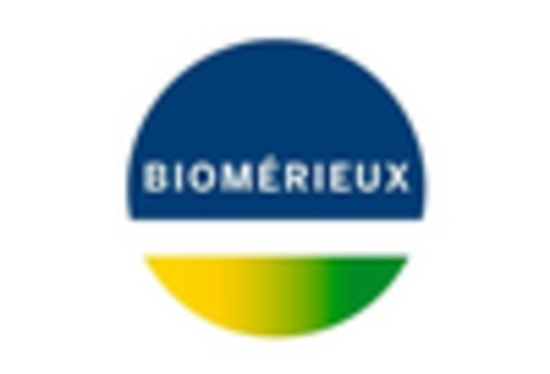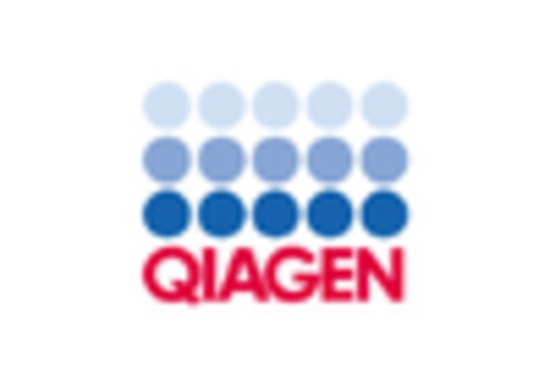Emergence of Personalized Medicine
The trend towards personalized medicine is reshaping the Virology Testing Market. As healthcare moves towards tailored treatment approaches, the need for precise diagnostic tools becomes paramount. Personalized medicine relies on accurate virology testing to determine the most effective treatment plans for patients based on their unique genetic profiles and viral strains. This shift is likely to drive innovation in testing methodologies, as companies strive to develop more sophisticated and targeted diagnostic solutions. Market projections indicate that the personalized medicine segment will experience significant growth, as healthcare providers increasingly adopt these approaches to enhance patient care and treatment outcomes.
Rising Incidence of Viral Infections
The increasing prevalence of viral infections is a primary driver for the Virology Testing Market. As the incidence of diseases such as hepatitis, HIV, and influenza rises, the demand for accurate and timely testing solutions escalates. According to recent estimates, viral infections account for a substantial portion of global morbidity and mortality, necessitating enhanced diagnostic capabilities. This trend is likely to propel investments in virology testing technologies, as healthcare providers seek to improve patient outcomes through early detection and treatment. Furthermore, the growing awareness of viral diseases among the public is expected to drive demand for testing services, thereby expanding the market for virology testing solutions.
Advancements in Diagnostic Technologies
Technological innovations in diagnostic methodologies are significantly influencing the Virology Testing Market. The introduction of advanced techniques such as polymerase chain reaction (PCR), next-generation sequencing (NGS), and rapid antigen tests has revolutionized the way viral infections are diagnosed. These technologies offer higher sensitivity and specificity, enabling healthcare professionals to detect viral pathogens with greater accuracy. Market data indicates that the PCR segment alone is projected to witness substantial growth, driven by its widespread application in clinical laboratories. As diagnostic technologies continue to evolve, they are expected to enhance the efficiency of virology testing, thereby attracting more healthcare facilities to adopt these advanced solutions.
Growing Awareness of Preventive Healthcare
The rising emphasis on preventive healthcare is significantly impacting the Virology Testing Market. As individuals become more health-conscious, there is a growing demand for regular health screenings, including virology testing. This shift towards preventive measures is likely to be fueled by educational campaigns and initiatives promoting the importance of early detection of viral infections. Market analysis suggests that this trend is contributing to an increase in the number of individuals seeking testing services, thereby expanding the market. Additionally, healthcare providers are increasingly recommending routine virology testing as part of comprehensive health assessments, further driving demand in this sector.
Increased Government Funding for Healthcare
Government initiatives aimed at bolstering healthcare infrastructure are playing a crucial role in the Virology Testing Market. Increased funding for public health programs, particularly in the realm of infectious disease control, is likely to enhance the availability and accessibility of virology testing services. Many governments are prioritizing investments in diagnostic capabilities to better prepare for and respond to viral outbreaks. This trend is reflected in budget allocations for healthcare, which have seen a marked increase in recent years. As a result, the demand for virology testing is expected to rise, driven by enhanced public health strategies and the need for comprehensive surveillance systems.


















Leave a Comment